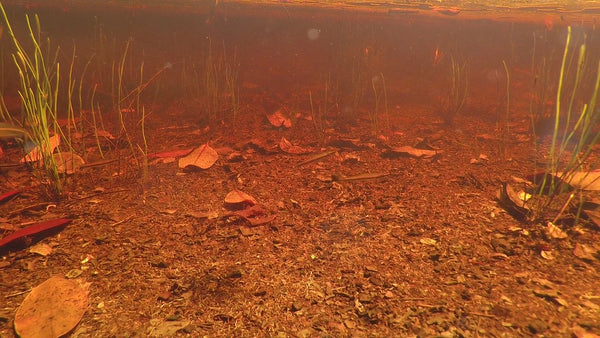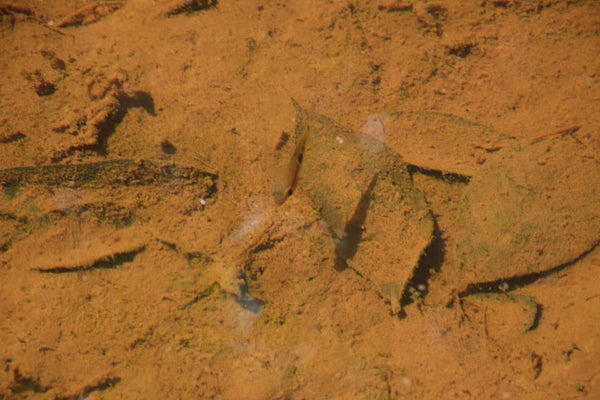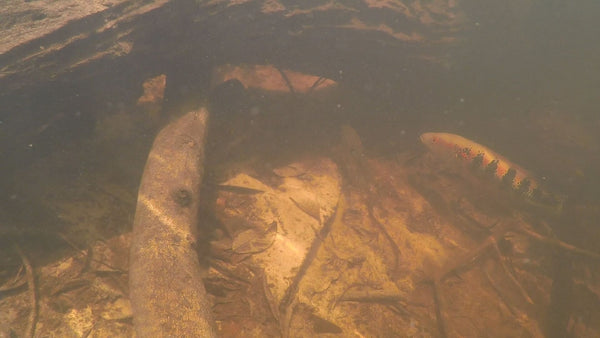- Continue Shopping
- Your Cart is Empty
Rethinking aquascaping from the bottom up...a few (disorganized) thoughts...

For some reason, I've been on this real "kick" about natural waterways, and how the water actually gets into them, and what characteristics impact the aquatic habitats we love to replicate. I think this is so incredibly important...As aquarists, we spend a ridiculous amount of time studying aquascaping technique from the standpoint of "ratios", "color utilization", perspectives, etc...However, from what I can tell, comparatively little time is spent attempting to understand how and why the natural habitats evolve and function, and how we can utilize this information in our 'scapes.
Ouch..
Yeah, we talk so much in the hobby about aquascaping, creating very unique aquarium displays, and utilizing all sorts of materials to achieve that goal. We talk about seemingly every little aspect of the craft...like selecting and arranging the perfect rocks to create harmony and to satisfy "design principles." Okay, I get it. Well, I get it, but I am curious as to why we don't look at the way NATURE arranges rocks, plants, underwater features. Is nature somehow not inspiring enough? I say it tongue firmly in cheek, but honestly, I'm always a bit surprised by what most of the aquarium world's definition of a "natural-looking" aquarium" is.
And since I have a website, internet bandwidth, and a healthy interest in the arcane...let's talk about it!

Now, before I begin my little "stream of consciousness" review, let me clarify: Every time I suggest that we've "over-indexed" on the "art" side of aquascaping, I get roundly trashed by one or two readers, who love to remind me that not everyone thinks that "decomposing leaves and plant parts" (from an actual response) are great aquascaping. Look, I"m NOT suggesting that at all. I'm not shrugging off the worldwide talent here. What I am suggesting is that, in addition to our love of great design, we take a good, hard, serious look at real-deal natural aquatic habitats and take a few more cues from them than we seem to be. And yes, I am NOT heaping the biotope crowd in this generalization. They really get this idea!
While the latest aquascaping contest designs are undeniably gorgeous and require obscene talent, it's hard to argue with the "designer" (Nature) who's been doing it better for longer. We've been 'scaping tanks for like 100 years...Nature's been creating aquatic habitats for..oh, I dunno...eons- so I suggest that, perhaps, we should just take a closer look once in a while. Some pretty good ideas there!
That's all.
One of the things that I always find a bit interesting in our aquascaping is that many of us just sort of seem to apply little thought to the substrate of our aquariums. I mean, if you're a planted aquarium geek, you'll spend a huge amount of time creating an "active" bottom, composed of varying fertilizers, aquatic sands, etc. However, the majority of us tend to find a substrate that looks cool to us, wash it, and throw it on the bottom. Done.
Now, we can give credit to those "competition" 'scapers here. Many will play with the contours a bit as they arrange rock (I'm thinking about the Iwagumi crowd), sloping it from the back and sides. This is very cool, surprisingly natural, and really opens things up in a 'scape...Hats off to them! Contours and variations in the bottom are hugely important and very natural! I saw this in action with my friend Luis Navarro last week...the attention to detail he paid to the bottom contours was amazing!
Sadly, however, it seems that very little attention is paid by the vast majority of hobbyists to the bottom of streams and rivers as it appears in nature, and how they "works" with the entire environment. I admit, I've been kind of guilty of this, and it's only been recently that I really gave more than a passing thought to what goes on "down there" in nature, especially in streams and rivers. It's a lot more interesting, when you examine the subject more closely- especially from the perspective of how these structures came to be, and what implications they have for fish populations...cool stuff.

Stream and river bottom composition is affected by things like regional weather, current, geology, the surrounding dry lands, and a host of other factors- all of which could make planning your next aquarium even more interesting if you take them into consideration!

We've touched on these in some recent posts, and we'll definitely dive deeper in upcoming blogs. There's more to this tank just the accumulation of leaves and such. It's pretty interesting...

If we focus on streams, which are one my personal areas of interest, it's important to note that the volume of water entering the stream, helps in part determine the amount and size of sediment particles that can be carried along, and thus comprise the substrate and it's contours.

The composition of bottom materials and the depth of the channel are always changing in response to the flow in a given stream, affecting the composition and ecology in many ways.

Permanent streams will often have different volume and material composition (usually finely-packed sands and gravels, with lots of smooth stones) than more intermittent streams, which are the result of inundation caused by rain, etc., or even so-called "ephemeral" streams, which typically occur only immediately after rain events (which means they usually don't have fish in them unless they are washed into them from more permanent watercourses). The latter two stream types are typically more affected by leaves, botanical debris, branches, and other materials. Like the igarapes ("canoe ways") of Brazil...little channels and rivulets which come and go with the seasonal rains. And then, there's those flooded Igapo forests we obsess over.

In the overall Amazon region (you knew I was sort of headed back that way, right?), it sort of works both ways, with the rivers influencing the surrounding land...and then the land "giving" some of the materials back to the rivers...the extensive lowland areas bordering the river and its tributaries, known as varzeas (“floodplains”), are subject to annual flooding, which helps foster enrichment of the aquatic environment. Although many streams derive their food base from leaves and organic matter, there is a lot of other material present that contributes to its structure. Think along those lines when scheming your next aquarium. Ask yourself what factors would contribute to the bottom composition of the area you're taking inspiration from.

You'll see a variety of bottom compositions in Amazonian and other streams, ranging from the aforementioned leaves and detritus in stream margins, to sand and silt over "cobbles", to boulders covered in algae, to fine patch gravels, and even just silt.

You might even say that rivers and streams act like nature's "sediment sorting machines", as they move debris, geologic materials, and botanicals along their courses. And along the way, varying ecological communities are assembled, with all sorts of different fishes being attracted to different niches.

Interestingly, in streams, the primary producers of the food webs that attract our fishes are algae and diatoms, which are typically found on rocks and wood wherever light and nutrients create optimum conditions for their growth. Organic material that enters streams via leaf fall is acted upon by fungi and small organisms, which help break it down. It is probably no surprise, then, that bacteria (especially in biofilms!) and fungi are the initial consumers of the organic materials that accumulate on the bottom. Like, the stuff many of us loathe. These, in turn, are extremely vital to fishes as a food source. Hence, one of the things I love so much about utilizing a leaf litter bed as a big part of your substrate composition in an aquarium! Of course, we talk about that all the time, right?

(Oh, by the way- Cory Hopkins' leaf litter tank proves that you CAN have both high design and natural form/function!)
Streams which flow over stony, open bottoms, free from natural obstacles like tree trunks and such, tend to develop a rich algal turf on their surfaces.

While not something a lot of hobbyists like to see in their tanks (with the exception of Mbuna guys and weirdos like me), algae-covered stones and rocks are entirely natural and appropriate for the bottom of many aquariums! (enter a tank with THAT in the next international aquascaping contest and watch the ensuing judge "freak-out" it causes! ) Grazing fishes, of course, will feed extensively on or among these algal films, and would be logical choices for a stony-bottom-themed aquarium. When we think about the way natural fish communities are assembled in rivers and streams, it's almost always as a result of adaptations to the physical environment and food sources.

Now, not everyone wants to have algae-covered stones or a mass of decomposing leaves on the bottom of their aquarium. I totally get THAT! However, I think that considering the role that these materials play in the composition of streams and the lives of the fishes which inhabit them is important, and entirely consistent with our goal of creating the most natural, effective aquariums for the animals which we keep. As a hobbyist, you can employ elements of these natural systems in a variety of aquariums, using any number of readily-available materials to do the job.

I hope you enjoyed this incredibly brief, wildly superficial collection of thoughts on the natural stream substrates and how they can impact our aquascaping decisions. And I hope that you've taken it in the spirit in which it was intended: To get us to look just a bit more at nature for inspiration, and to ask ourselves the "hows and whys" when considering the natural habitats and replicating them in our tanks.

Mostly, I hope they inspire you to do some further research of your own, and to incorporate your findings from the natural world into your next aquarium design. We have literally an entire planet of amazing habitats from which to draw inspiration, which, in my opinion, is far more interesting and inspiring than "last month's 'Tank of The Month' winner." Then again, I'm a guy whose idea of a cool aquascape involves brown water, decaying leaves, and piles of seed pods..so, yeah...
Until next time...do the research. Look to nature.
Stay inspired. Stay excited. Stay curious. Stay creative. Stay passionate.
And Stay Wet.
Scott Fellman
Tannin Aquatics
(Special THANKS! to David Sobry and Mike Tuccinardi for their incredible pics used extensively in this piece!)








Scott Fellman
Author